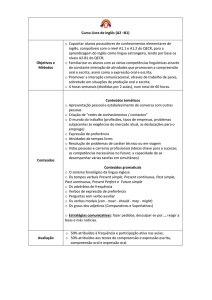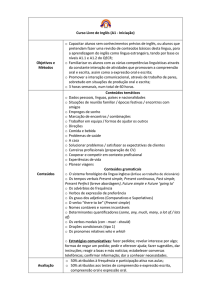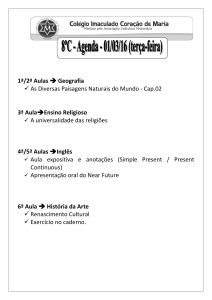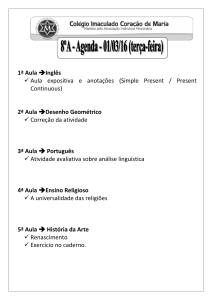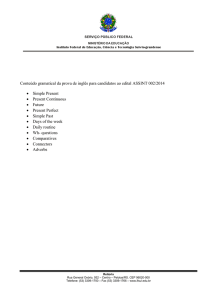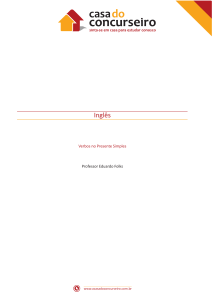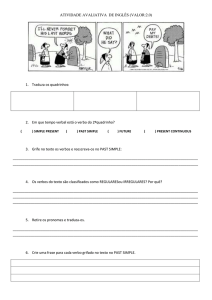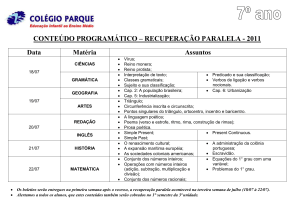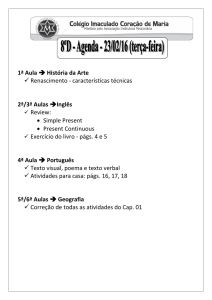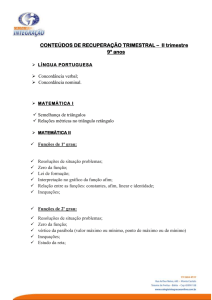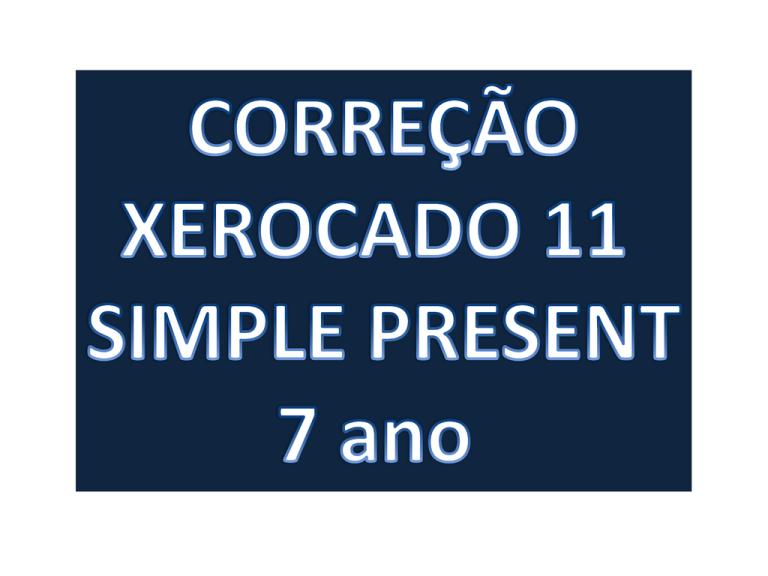
1. Usa-se o Simple Present para falar de hábitos, rotina,
acontecimentos ou ações que acorrem regularmente,
com frequência.
Ex:
I always use the computer at night.
My brother goes to work every day.
2. Usa-se o Simple Present para expressar verdades
universais e leis.
Ex: The Earth is round.
Water freezes at 0º C.
3. Usa-se o Simple Present para expressar um fato ou uma
situação atual.
Ex: Classes start at 7:00 a.m. at Módulo.
Cláudia teaches English in Public schools.
+S
+ ES
MAIORIA DOS VERBOS
OBS: VERB TO HAVE:
I HAVE two brothers.
She HAS two brothers.
+ IES
De acordo com a sua pesquisa sobre Simple Present e o
quadro anterior, complete as informações:
1. Observando a conjugação verbal das pessoas I / YOU /
WE / THEY podemos concluir que
OS VERBOS NÃO MUDAM A SUA ESCRITA, OU SEJA A
CONJUGAÇÃO PERMANECE A MESMA DA FORMA
ORIGINAL SEM O TO.
De acordo com a sua pesquisa sobre Simple Present e o
quadro anterior, complete as informações:
2. Observando a conjugação da 3a pessoa do singular, HE /
SHE / IT, podemos concluir que:
2.1 A maioria dos verbos:
FAZEM
A
CONJUGAÇÃO
DO
SIMPLE
PRESENT
ACRESCENTANDO-SE À SUA FORMA ORIGINAL A
TERMINAÇÃO
+S
De acordo com a sua pesquisa sobre Simple Present e o
quadro anterior, complete as informações:
2. Observando a conjugação da 3a pessoa do singular, HE /
SHE / IT, podemos concluir que:
2.2 Verbos terminados em O / S / SS / SH / CH / X / Z:
FAZEM
A
CONJUGAÇÃO
DO
SIMPLE
PRESENT
ACRESCENTANDO-SE À SUA FORMA ORIGINAL A
TERMINAÇÃO
+ ES
De acordo com a sua pesquisa sobre Simple Present e o
quadro anterior, complete as informações:
2. Observando a conjugação da 3a pessoa do singular, HE /
SHE / IT, podemos concluir que:
2.3 Verbos terminados em y que são precedidos de consoante:
FAZEM
A
CONJUGAÇÃO
DO
SIMPLE
PRESENT
ACRESCENTANDO-SE À SUA FORMA ORIGINAL A
TERMINAÇÃO
+ IES
1. Complete as frases abaixo com o Simple Present Tense
dos verbos entre parênteses.
OBS: Lembre-se de analisar o sujeito de cada frase, pois é
ele que vai determinar se o verbo recebe as terminações
(+S , + ES ou + IES) ou não.
a) She HURRIES to catch the bus every day. (hurry)
b) You SPEAK English fluently. (speak)
c) The boys often GO to the park. (go)
d) Marina and Julia WRITE in their diary. (write)
e) He STUDIES English. (study)
f) They HAVE lunch at 12:00 am. (have)
1. Complete as frases abaixo com o Simple Present Tense
dos verbos entre parênteses.
g) Pedro BRUSHES his dog every Sunday. (brush)
h) The baby CRIES a lot at night. (cry)
i) Pierre GOES to school in the morning. (go)
j) Karina PLAYS volleyball twice a week. (play)
k) Patrícia and Mônica often WATCH the news on TV.
(watch)
l) Marina HAS a big family: 3 sisters and 4 brothers. (have)
m) My friends sometimes STUDY with a particular teacher.
(study)
2. Order the words to form correct sentences. Pay attention to
the verbs!!!!!!!
a) Internet / I / the / surf / sometimes.
I SOMETIMES SURF THE INTERNET.
b) rarely / eat / she / fast food.
SHE RARELY EATS FAST FOOD.
c) listen / usually / Julia / to music / in the shower.
JULIA USUALLY LISTENS TO MUSIC IN THE SHOWER.
d) is / late / always / for school / friend / my.
MY FRIEND IS ALWAYS LATE FOR SCHOOL.
e) mom / watch / in English / my / films / often.
MY MOM OFTEN WATCHES FILMS IN ENGLISH.
03. Observe as frases abaixo e responda o que se pede.
( 1 ) loves = (+S).
( 2 ) kisses = (+ES)
( 3 ) studies (+IES)
(
(
(
(
(
(
(
(
1
1
2
3
1
2
1
2
) to play
) to dance
) to go
) to cry
) to drink
) to wash
) to buy
) to fix
(
(
(
(
(
(
(
(
1
2
1
2
3
2
1
1
) to eat
) to watch
) to make
) to teach
) to try
) to do
) to stay
) to clean
(
(
(
(
(
(
(
(
1 ) to serve
3 ) to hurry
1 ) to read
3 ) to study
1 ) to sing
1 ) to live
1 ) to sleep
2 ) to pass
(
(
(
(
(
(
(
(
3 ) to fly
2 ) to brush
2 ) to buzz
1 ) to get up
2 ) to catch
1 ) to start
1 ) to pray
1 ) to see
04. Observe as frases abaixo e sublinhe todos os verbos.
Verifique se eles estão conjugados corretamente no Simple
Present Tense. Caso a conjugação esteja errada, conserte e
justifique.
a) ( E ) Dad wash the cat every Sunday.
RESP: WASHES – O SUJEITO DA FRASE É DE 3ª PESSOA DO
SINGULAR E
POR ISSO O VERBO PRECISA ESTAR
FLEXIONADO E RECEBER A TERMINAÇÃO ES.
04. Observe as frases abaixo e sublinhe todos os verbos.
Verifique se eles estão conjugados corretamente no Simple
Present Tense. Caso a conjugação esteja errada, conserte e
justifique.
b) ( E ) My brother and I does our exercise in the afternoon.
RESP: DO – O SUJEITO NÃO É DE 3ª PESSOA DO SINGULAR
E POR ISSO O VERBO NÃO DEVE ESTAR FLEXIONADO.
c) ( E ) Kate study Japanese because she want to travel to
Japan.
RESP: STUDIES / WANTS – O SUJEITO DA FRASE É DE 3ª
PESSOA DO SINGULAR E POR ISSO O VERBO PRECISA
ESTAR FLEXIONADO. STUDY RECEBE A TERMINAÇÃO IES E
WANT RECEBE A TERMINAÇÃO S.
d) ( C ) Bill always goes to school by bus.
e) ( C ) Carol and Peter clean their room every day.
05. Observe as frases abaixo e justifique as diferentes
conjugações para o mesmo verbo.
A: My sister studies English every day.
B: My sister and I study English every day.
NA FRASE A, O SUJEITO (MY SISTER = SHE) É DE 3ª
PESSOA DO SINGULAR E POR ISSO O VERBO DEVE SER
FLEXIONADO RECEBENDO A TERMINAÇÃO IES.
JÁ NA FRASE B, O SUJEITO (MY SISTER AND I = WE) NÃO
É DE 3ª PESSOA DO SINGULAR E POR ISSO O VERBO NÃO
SOFRE FLEXÃO, MANTENDO-SE NA SUA FORMA DE
INFINITIVO.
6. Escreva a rotina de Maggie, em inglês, usando os verbos
dados e os horários.
a) MAGGIE WAKES UP UP AT SIX O’CLOCK.
b) SHE TAKES A SHOWER AT SIX THIRTY.
c) SHE HAS BREAKFAST AT SEVEN O’CLOCK.
6. Escreva a rotina de Maggie, em inglês, usando os verbos
dados e os horários.
d) SHE STUDIES AT EIGHT O’CLOCK.
e) SHE HAS LUNCH AT TWELVE THIRTY.
F) SHE DOES HER HOMEWORK AT TWO O’CLOCK.
6. Escreva a rotina de Maggie, em inglês, usando os verbos
dados e os horários.
g) SHE LISTENS TO MUSIC AT FIVE O’CLOCK.
h) SHE HELPS HER MOTHER AT EIGHT O’CLOCK.
I) SHE SLEEPS AT TEM O’CLOCK.

![[1] 22 Data Turma PROFESSOR / DISCIPLINA](http://s1.studylibpt.com/store/data/004886036_1-b8320e9a49af981e1e6084997649e677-300x300.png)
